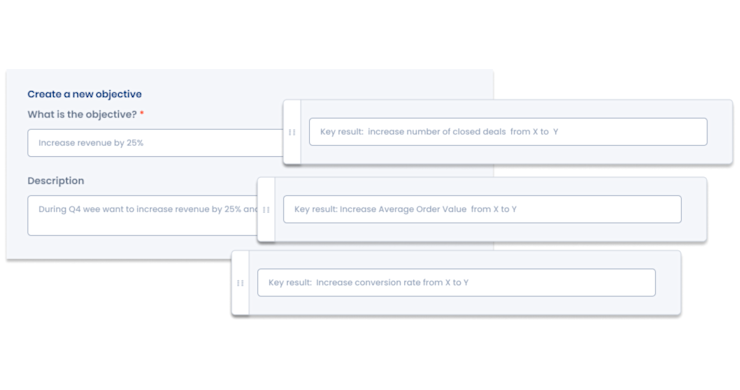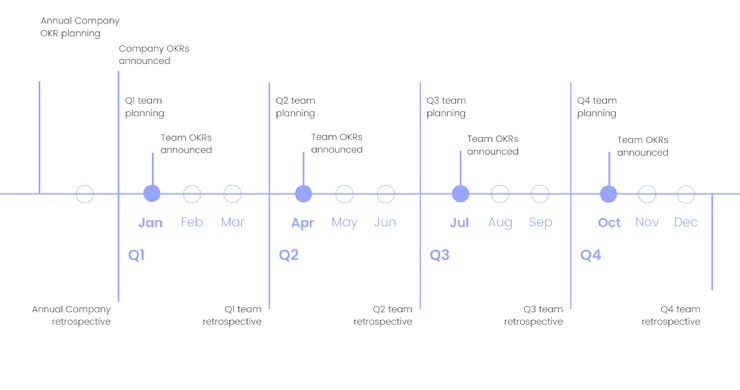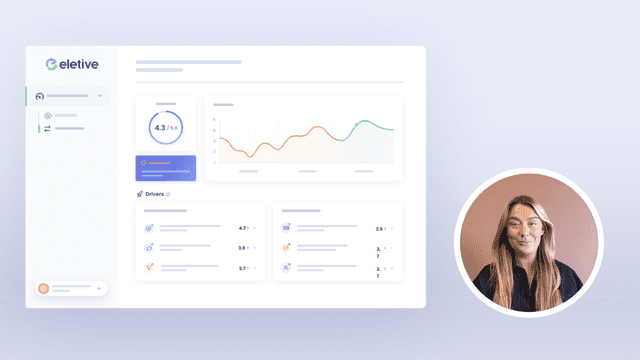OKRs (Objectives and Key Results) is a collaborative goal-setting method that helps teams and individuals to set – and reach – ambitious goals with measurable results.
OKRs offer a powerful method for tracking progress, creating alignment, and encouraging engagement around common goals.
Table of Contents
What is OKRs?
What is the difference between OKRs and KPIs?
OKRs vs SMART goals
Objectives, Key Results, and Initiatives/Actions
5 benefits of Objectives and Key Results
Aligning the different levels of the organization
Different alignment strategies
How often should OKRs be updated?
3 steps to set the right Objectives and Key Results
Operational considerations
Executive buy-in
Rolling out your OKR program
Frequently Asked Questions
Key takeaways
What is OKRs?
Setting goals is a crucial part of any performance management strategy. Goals set the direction and act as the northern star guiding teams in their efforts. OKRs offer a powerful method for tracking progress, creating alignment, and encouraging engagement around common goals.
OKR is an acronym that stands for Objectives and Key Results. It’s a popular framework for goal management, that helps organisations visualise their strategy – and execute it. The way that OKRs can help companies achieve this, is by organising the team members, teams, and departments – as well as the work they do – around common Objectives.
There have been many goal-setting frameworks trending throughout the years, but while some are quickly forgotten, OKRs have become a widely used and loved methodology. It was originally established by Andy Grove, a management scientist at Intel, in the early 1990s, and later on, OKRs were made well-known by Google. Thousands of businesses, including Spotify, Amazon, and the US Navy, are powered by OKRs today.
What is the difference between OKRs and KPIs?
KPIs and OKRs are different types of metrics. One way of thinking about it is to imagine your organisation as a car driving towards a destination. That destination is your vision, your ultimate goal. In that analogy, the OKRs are a way to build your roadmap and make sure you’re traveling in the right direction.
However, you need to keep an eye on your dashboard on your way to the destination. You check that you have enough gas, oil, washer fluid, and so on. And just as you need to keep an eye on those metrics while driving, you need to keep an eye on your KPIs while working towards your objectives. KPIs are the indicators that tell give you immediate information about your organisation’s performance. They show you if you're heading in the right direction, and if you're moving at an accurate speed.
KPIs and OKRs are different ways to measure and frame your goals, and one does not exclude the other. While KPIs are the metrics that reflect performance, OKRs are the goal-setting framework to help your organisation improve performance and focus on what matters in order to do so.
KPIs measure performance but don’t tell you what needs to improve to grow those numbers. They are high-level business performance indicators that you track regularly ( quarterly, monthly, weekly, and so on).
OKRs help you decide what needs to be changed or improved. When you’ve decided on what areas are central and need improvement, you set an Objective for that area, and add Key Results for measuring your progress towards this Objective.
OKRs vs SMART goals
SMART goals is an acronym for goals that are Specific, Measurable, Assignable, Realistic, and Time-bound. SMART is a great guide for crafting your objectives - but has no focus on key results, tactics, or initiatives. While SMART goals pose the question “what is the goal?”, OKRs add the important layer of “how do we get there?"
Objectives, Key Results, and Initiatives
An OKR consists of an Objective, which tells you where to go, and a set of Key Results, which are the measurable results you need to achieve to reach your Objective. Initiatives are the different projects and tasks that will ensure you achieve your Key Results.
OKRs - a way to focus on outcomes over outputs
A common pitfall when it comes to measuring performance and productivity is focusing on outputs instead of outcomes. That’s when people fall into the trap of “busy work”, instead of identifying the work that actually matters and moves the needle. This is where the OKR framework can make an enormous difference, as it helps everyone in the organisation focus on the right things.

Examples of Objectives, Key Results, and Initiatives/Actions
Before going into detail about how to write powerful and effective OKRs, let’s have a closer look at the different parts of an OKR: Objectives, Key Results, and Initiatives.
It’s helpful to keep in mind that Objectives, Key Results, and Initiatives provide the answers to three important questions:
1. Where do we need to go?
2. How will we know if we’re getting there?
3. What will we do to get there?
Objective: Where do we need to go?
The answer to the first question is your Objective. It sets a clear direction, comparable to a destination.
Examples of Objectives:
Provide the best customer experience in our industry
Increase growth compared to last quarter
Key Result: How will we know if we’re getting there?
The answer to the second question is your Key Results for that Objective. It should be measurable to help you verify that you’re moving closer to your target.
Examples of Key Results:
Increase our NPS to 75
Close X amount in new deals
Initiative/Actions: What will we do to get there?
The answers to the third question are your Initiatives. Those are the actions you will take to reach your Key Results and as a consequence, achieve your Objective.
Examples of Initiatives:
Implement an LMS system to improve our customer onboarding journey
Hold 3 coaching sessions to upskill our account executives
5 benefits of Objectives and Key Results
When properly implemented, OKRs encourage creativity, bring people together, and lay out a clear roadmap for advancing the business. OKRs provide a framework for setting objectives and tracking progress that assists companies in managing performance in five key ways:
1. Better alignment
OKRs bring everyone together. They foster a feeling of agreement on the job that teams are performing, their motivations, and how their efforts advance the company. Companies make sure that everyone in the company is linked to the same purpose and working toward the same goals by laddering up individual and team objectives to top-level corporate objectives.
2. Improved prioritisation
OKRs take broad concepts and reduce them to specific, quantifiable actions. Employees are given the authority to prioritize both short-term and long-term goals as a result. OKRs bridge the gap between bigger objectives and the everyday effort required to attain them by providing a blueprint for bringing big-picture aspirations to reality.
3. Increased transparency
OKRs promote open corporate cultures. They do this by making sure that everyone, from the CEO to the intern, is aware of the importance and influence of teams and people throughout the whole business. The marketing and sales teams may make better choices that affect their performance and the company when they are informed of what is occurring in product or engineering.
4. Clear accountability
OKRs show how far along people, teams, and the whole organisation are in carrying out the common business objective. The fact that OKRs are linked to concrete, quantifiable milestones makes it clear who is accountable for attaining certain objectives and establishes responsibility for performance expectations.
5. Empowered teams and employees
OKRs let employees feel in control of their development by demonstrating the effects of their efforts. Employees are more likely to arrive with the motivation, dedication, and creativity required for innovation when they feel that they have a hand in setting objectives and success criteria.
Aligning the different levels in the organization
Only when appropriately implemented, OKRs provide focus, accountability, transparency, and alignment across the whole organisation. To be successful, OKRs should be developed top-down, starting at the organisational level and working down to the team level, and sometimes individual level. Strategic goals are often established at the executive level and serve as a reference for establishing the team and personal goals.
Additionally, OKRs should be supported from the bottom up, which means that team and individual goals should be linked to overarching organisational goals using quantifiable key outcomes. Employee engagement is increased and overall company alignment is created through the interaction of these business objectives.
• Company: Company OKRs concentrate on long-term objectives that the company wishes to achieve over a considerable amount of time. Executive teams may complete these, but they need to be developed with support from all departments.
• Team: Each team's collective goals are prioritised by the team's OKRs. These should concentrate on supporting company-level important goals and objectives instead of detailing specific OKRs.
• Individual: Each employee's own OKRs outline their goals. These are often created by workers and contribute to the team and organisational OKRs.
The OKR model encourages businesses and employees to give priority to the goals that will have the biggest effects on the firm by recommending three to five objectives for each level of an organisation.
Different alignment strategies
Although OKR alignment across organisational levels is something that all businesses should strive for, there are two ways that they may do it.
• Strict alignment: With this strategy, important outcomes are strongly related to the goals of the level below them. Each crucial outcome required to achieve a company-level goal then becomes a team-level goal. Key team outcomes then translate into personal goals for team members.
• Directional alignment: Using this more adaptable method of goal-setting, companies define goals that contribute to but do not precisely duplicate the primary outcomes of higher levels. This guarantees that goals stay qualitative and that the most important outcomes stay quantifiable and measurable.
Aligning team, company, and individual objectives is important, but avoid getting bogged down in the details. We advise businesses to directionally align OKRs to increase goal-setting flexibility and prevent spending time attempting to properly cascade objectives (more on this later).
How often should OKRs be updated?
The size, sector, and growth rate of your organisation will determine how often you should update your OKRs. Businesses that expand slowly and steadily have fundamentally different needs than those whose surroundings change quickly.
A common approach is to set Objectives for the full year and to update the key results on a quarterly basis. This cadence not only helps everyone feel more connected to the objectives but also enables your team to change the goals as necessary.
3 steps to set the right Objectives and Key Results
By fusing ambition and pragmatism, the OKR technique differs from other goal-setting frameworks. Objectives and important outcomes are also intended to promote responsibility and transparency at the corporate, team, and individual levels.
There are three things that are good to keep in mind, in order to set effective OKRs:
1. Objectives should be ambitious and inspiring
The objectives should be challenging, which means they should be just a little bit beyond what appears doable or comfortable. Setting objectives with an inspiring aim will encourage individuals across your organisation to dream larger. Setting stretch goals is one of the keys to OKR success.
2. Key results must be measurable and time-bound
Each important outcome must be connected to a concrete achievement and crafted to make the goal attainable. Measurable key outcomes offer objectives with a limited endpoint, enabling employees to know precisely what they should be focusing on, and enabling organisations to precisely measure how much progress has been accomplished.
3. Objectives and Key Results should be transparent and easy to access
People commit to themselves, their team members, and the organisation as a whole when they are open and honest about their aspirations. This facilitates cooperation among stakeholders, builds a feeling of responsibility, and provides teams with context so they may make wise choices. Ensure that OKRs are established and maintained in a method that is simple for everyone to use and track.
Designing the OKR program
Before launching a fully-fledged OKR program, it’s important to identify how your organization will configure and track your OKRs, to design a process that suits your needs. Below we outline the fundamentals to consider before rolling out your OKR program.
Mission, Vision, and Strategy
Companies should identify the objective, vision, and strategy that their OKRs can serve before launching an OKR program. Before you start preparing, be sure that these essential success factors are in place.
• Vision: Your vision statement is a reflection of what you want the world and your organization to become. As an example, our vision at Eletive is:
“Our vision is a world where people thrive at work. Where each individual has a voice and is empowered to perform at their best.”
• Mission: Your mission statement is where you outline what you aim to do to achieve your vision. To use Eletive as an example again, our mission is:
“Our mission is to make that world possible by providing forward-thinking technology that empowers HR, managers, and employees to own and shape their work environment, employee experience, and performance.”
• Strategy: Every organization needs a strategy. Determine your target audience, their motivations, and what you have to offer. Before diving into OKRs, it is a good idea to devote some extra effort to updating and documenting your overall strategy.
Your overarching vision and mission should be supported by your OKRs, which should be translated from your strategy, and drive the realisation of your vision.
Operational considerations
Predictability: How often do you change your objectives? Normally, are they so close
Business cycles: Do you know when it is busy or slow?
Work type: What kind of work is needed in your industry? (For example, project- or research-based?)
Headcount: How big is your business now, and how fast is it growing?
Organizational structure: Is it hierarchical or flat in your company?
History: Are there any legacy goal-setting procedures that need to be taken into account?
Executive buy-in
For a successful implementation of OKRs, it’s essential that there is complete buy-in and participation from the top management level. If the initiative is run by the HR team, there is a risk that OKRs are perceived as mainly an administrative procedure. Executive sponsorship is crucial for an OKRs plan rollout to be effective.
Also, consider where in the company you want to start implementing this new framework. When you create your OKRs strategy, it can be wise to implement it in increments, rather than including the whole organisation in one take. After first successfully deploying OKRs in the leadership teams, many organisations then choose to start with smaller pilot programs and then extend to other departments.
Rolling Out Your OKR Program
Implementation Timeline
If you are choosing quarterly OKRs and this is your first time implementing an OKRs program, it’s good practice to start your goal-setting cycle around six weeks before the beginning of a new quarter.

The objective-setting process should be prioritised at all levels so that none of the later levels are delayed. It is crucial to schedule any communications and training sessions in good time so that employees can participate and the process doesn’t feel rushed.
Choosing the right OKR tool
The practice of monitoring OKRs requires a shared platform for the whole company, where the OKRs can be documented and where the progress can be tracked.
Some companies have built their own internal tools. Others use ad hoc strategies like spreadsheets, and an increasing number of businesses utilise specialised goal-tracking software to make OKRs accountable and visible.
No matter the tracking tools you use, it's essential to have a clear process in place before implementing OKRs at your organisation to get the most out of the framework.
How to administer OKRs
Sharing Progress
Regular meetings to review OKRs are essential. All levels of your business should gather at the start of each quarter to review the previous goal cycle. The format of this meeting may vary based on the size of your business, but normally each team leader will go through their Objectives and Key results and talk about changes for the next quarter.
● Company: Every month, discuss company-level progress, preferably at all-hands meetings. Check for team updates, and contact department or business unit leaders who do not provide updates.
● Team: Discuss departmental progress at least once a month, preferably at team meetings. If your team's units are not publishing progress, check your team's reports for updates & follow up with team heads or managers.
● Individual: Managers and direct reports should include OKRs in one-on-one sessions. Managers should ask for updates from people.
Companies should update and evaluate OKR progress throughout the cycle as a recommended practice. Instead, frequent updates on progress should be disseminated throughout organisational levels.
Sharing and integrating learnings
Integrating lessons learned from the process and execution of the OKRs itself into the next objectives cycle is the last stage in putting an OKR program into action. Regular OKR evaluations should take place, but each cycle should also end with a more in-depth reflection on what went well, what didn't, and what lessons may be transferred to the next cycle. Everyone should consider the following questions:
Did I reach every one of my goals?
If yes, what factors helped me succeed?
If not, what challenges did I face?
What would I modify if I were to redo a goal that was fully attained?
What have I learned that could change how I approach the OKRs for the next cycle?
Key takeaways
An OKR framework is an effective tool for assisting organisations in defining objectives and the quantifiable steps that will support them. When used properly, OKRs may bring teams together, stimulate creativity, and promote cooperation inside enterprises. Here are a few more pointers for implementing OKRs in your company:
Avoid fixating on level alignment.
Iterate and develop new OKRs using the lessons from previous iterations.
Emphasise executive support while introducing OKRs plans.
Regularly set OKRs, preferably every quarter but at least every six months
Ensure that OKRs are challenging, quantifiable, and open.
Use a modern tool to track your OKRs and make them visible to the whole organisation
Remember that it takes time to get everyone educated, on board, and in the groove. It’s OK if your company's OKRs are not flawless every quarter; just keep learning from every quarter, and eventually, you will have a powerful process for goal-setting and alignment in place.
OKR software helps you implement and track OKRs
The Eletive platform supports the OKR framework and helps you create transparency, alignment, and accountability around your business objectives and organisational goals. By gathering all the tools you need for employee engagement and performance management in one platform, Eletive helps you build a healthy and productive workplace where people thrive and perform at their best. Get in touch with our team of experts to learn more!
FAQ
Should OKRs prioritise outputs or results?
The goal of OKRs is to change the emphasis from production to outcomes. The primary distinction between these two ways of thinking is that whereas output concentrates on how things are accomplished, outcomes concentrate on what was accomplished. In other words, it is more crucial to acknowledge the success than the preparatory actions if an employee uses a non-traditional strategy to achieve a goal.
Who should own cross-functional objectives?
Cross-functional objectives may sometimes cause misunderstandings in businesses. Maintaining one owner per objective indeed is a recommended practice since it ensures responsibility. Given that, it is acceptable to assign different parties ownership of the same objective if your company considers it to be a cross-functional priority. Shared ownership of objectives may be successful if there is a defined division of labor. However, if you discover that everyone is co-owning an OKR, it may be a hint that you need to divide your goals into more manageable key outcomes.
How should OKRs be used in performance reviews?
There's no clear-cut answer to that. Some people have strong feelings about how OKRs and performance evaluations relate to one another. Some think that OKRs and performance talks should never be linked since doing so might create unhealthy demands at work and ignore soft skills that have a good influence on the company. Others feel that OKRs should be discussed at the performance review since they serve as a baseline for employee expectations and duties toward their peers.
In the end, every leadership team must make a choice for their own business. Regardless of your choice, keep in mind that OKRs are not the same as employee performance reviews. Businesses that want to link OKRs to performance should also include other parameters in the performance appraisal.

























